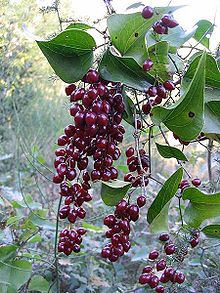Stinging bindweed
| Stinging bindweed | ||||||||||||
|---|---|---|---|---|---|---|---|---|---|---|---|---|

Smilax aristolochiifolia , |
||||||||||||
| Systematics | ||||||||||||
|
||||||||||||
| Scientific name | ||||||||||||
| Smilacaceae | ||||||||||||
| Vent. |
The stinging wind family (Smilacaceae) are a family in the order of the lily-like (Liliales). The only two genera with around 315 species are mainly found in the tropics to subtropics almost worldwide, only a few species thrive in temperate areas.
description


Vegetative characteristics
They are prickly, evergreen, perennial, woody or herbaceous plants that grow climbing in different ways . They form rhizomes or tubers as permanent organs. Above-ground parts of the plant can be hairy in some species. There is cork cambium. There is no secondary growth in thickness .
The mostly alternate, sometimes opposite leaves are stalked to almost sessile. The often leathery, coarse leaf blades are simple and have entire margins with reticulate veins. In some species, the leaves have an unpleasant smell. The stomata are anomocytic.
Generative characteristics
They are dioecious separate sexes ( diocesan ). The flowers stand together individually or in differently structured, for example, dold-like , spike-like or racemose inflorescences . The unisexual flowers are radial symmetry and threefold. There are two circles, each with three bracts , which are of the same or different shape and can be grown together freely to more or less high. The bracts of the inner circle can be reduced or fringed. In the male flowers there are usually six, rarely three, nine, twelve, 15 or 18 fertile stamens that can be free or fused. In the female flowers only rarely carpel available, usually three carpels are a top permanent, mostly dreifächerigen ovary grown. There are one or two ovules per ovary compartment. Most of the three styles are free or partially fused. The pollination is effected by insects ( Entomophilie ).
Fleshy berries are formed that usually contain one to three seeds. The seeds have an oily endosperm and a mostly small, well-developed embryo . The seed coat (testa) does not contain any phytomelan.
The basic chromosome numbers determined were x = 10, 13–16.
ingredients
There are saponins present.
Systematics and distribution
The family Smilacaceae was set up under the name "Smilaceae" in 1799 by Étienne Pierre Ventenat in Tableau du Regne Vegetal , 2, p. 146. The type genus is Smilax L. The species contained here were previously classified in the Liliaceae family.
The distribution is mainly pantropical and some species are found in temperate areas .
Only two genera with about 315 species belong to the family of the stinging bindweed family (Smilacaceae):
- Heterosmilax Kunth (Syn .: Oligosmilax Seem. , Pseudosmilax Hayata ): The approximately 13 species are widespread in Asia.
- Stingrays ( Smilax L. , Syn .: Coprosmanthus (Torrey) Kunth , Nemexia Raf. ): The 300 to 350 species are mainly found in the tropics to subtropics almost worldwide, only a few species thrive in temperate areas.
swell
- The family of Smilacaceae in APWebsite. (Section description and systematics)
- The Smilacaceae family at DELTA by L. Watson & MJ Dallwitz. (Section description)
- Walter C. Holmes: Smilacaceae. , P. 468 - the same text online as the printed work , In: Flora of North America Editorial Committee (Ed.): Flora of North America North of Mexico. Volume 26: Magnoliophyta: Liliidae: Liliales and Orchidales , Oxford University Press, New York and Oxford, 2002. ISBN 0-19-515208-5
- Chen Shi-Chao, Qiu Ying-Xiong, Wang Ai-Li, Kenneth M. Cameron & Fu Cheng-Xin: A phylogenetic analysis of the Smilacaceae based on morphological data , In: Acta Phytotaxonomica Sinica , Volume 44, Issue 2, 2006, Pp. 113-125.
Individual evidence
- ↑ Smilacaceae in the Germplasm Resources Information Network (GRIN), USDA , ARS , National Genetic Resources Program. National Germplasm Resources Laboratory, Beltsville, Maryland.